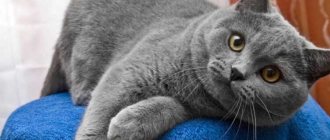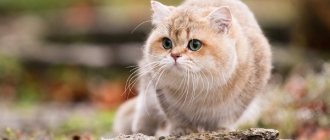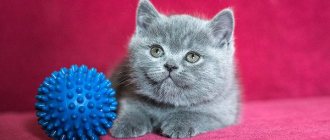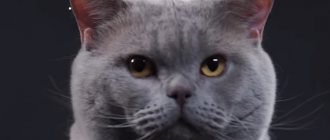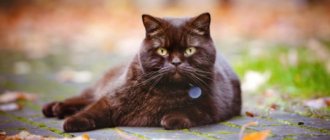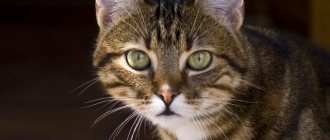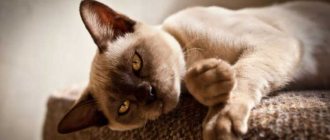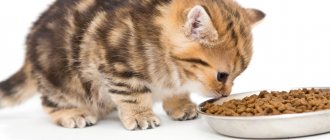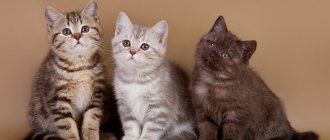Review author: “ZooVita”
The main distinguishing feature of this cat breed, from which it got its name, is its short hair, the appearance of which can be seen in the photo of a British Shorthair cat. There is no exact information about the homeland of this beautiful cat.
According to some sources, she appeared in France, while other sources claim that she is a descendant of Egyptian cats. The first exhibition at which this breed was presented took place in England in 1871.
After this exhibition, breeders and cat lovers paid attention to the British Shorthair, being impressed by the beauty of its dense coat.
The cat gained worldwide fame and distribution only in the 20th century, and was brought to the Russian Federation in 1980. Currently, the breed is popular all over the world.
Brief history of the breed
The British Shorthair breed has been around for a very long time. Today it is no longer possible to find any documents about how she ended up in England. According to one version, her ancestors were brought to the island by Roman conquerors.
True, the graceful, long-legged cats of the legionnaires, who protected food supplies from ship rats, were more reminiscent of Egyptian animals rather than the tightly built, round-faced modern British.
Over time, freedom-loving individuals spread throughout the British Isles and began to mate with local wild relatives. Their descendants lived next to people for several centuries and regularly destroyed rodents. For a long time, these cats were undeservedly deprived of attention, and only in the second half of the 19th century did people begin to show interest in them. They were first demonstrated at the London Exhibition on July 13, 1871, and from that moment they gained popularity.
After the Second World War, the British population declined catastrophically. To save the breed, cats began to be crossed with Persians, Chartreuxes and Russian Blues. Because of this, they did not receive recognition from leading felinological organizations for a long time.
In 1967, the American Cat Association listed them under the name "British Blue". In Russia they learned about the breed in 1980.
British Fold
There is an expression "loose-eared British", but this species does not exist. There are 2 breeds - the British Shorthair and the Scottish Fold. A separate variety of the latter is identified - the Scottish straight-eared (Scottish Straight), which is also called the pointed-eared.
All of these breeds are closely related and were once bred to each other. But in 2004, the WCF introduced a ban on mating Scottish and British cats.
British cat: interesting facts
During the existence of the breed, a lot of interesting things happened to it:
- The prototype of the Cheshire cat, described in Lewis Carroll's work "Alice in Wonderland", was British.
- Instead of the usual meowing, representatives of the breed make unusual croaking sounds.
- In the last century, blue color was recognized as the only correct color. A British cat of a different color was considered a cull.
- In the homeland of the breed it is simply called shorthair, which means “short-haired”.
Read more about the color of Whiskas cats in this article.
Place in the cat's horoscope
The fiery red, smooth-haired Briton is a handsome, smart, aristocrat, whose noble origin does not raise any doubts in anyone - he is the king and ruler of all the other cats in the house and the people around him.
Experts attribute the British breed to the astrological sign of the zodiac Leo. This is confirmed by the extraordinary charisma that British cats possess, as well as the fact that they are much larger than other felines and fearlessly rush into battle at the slightest suspicion of an insult to their greatness, although they are magnanimous and noble by nature.
You cannot say about such a cat that he is fat and lazy, because he is regal and majestic, and illuminates your home, honoring it with his presence. All the more valuable and touching are the manifestations of love and friendship a charismatic animal can bestow on a person.
Breed description, standards, appearance
British cats are massive animals, not without agility and grace. Their calling card is their thick, plush coat and full, rounded cheeks.
The breed standard was formed back in the 19th century and has remained virtually unchanged since then.
Dimensions and weight
British cats are medium to large in size. They have pronounced sexual dimorphism, so males are noticeably larger and heavier than females.
A British breed cat weighs between 3.5-6.5 kg. The cat's weight reaches 5.5-9 kg.
Anatomical characteristics
A typical representative of the breed should look consistent with the official description. The British Shorthair cat ideally has the following characteristics:
- The head is large, rounded with full cheeks and a weakly defined but noticeable stop. The nose is short and straight. The lobe forms a vertical line with the chin.
- The ears are neat, small, low set. Wide at the base, with rounded tips.
- The eyes are large and expressive. They have a rounded shape and wide set. Heterochromia is common in white British cats. Chinchilla-colored individuals come with lavender, green and blue eyes. The rest of the British people have orange irises.
- The body is massive, powerful with a deep chest, short muscular back and broad shoulders.
- The limbs are short, smooth, with rounded paws and strong, tight-fitting toes.
- The tail is thick, wide at the base, with a rounded tip. Moderately long.
Important! The British cat is a straight-eared cat. Folding indicates that the animal is not purebred or belongs to a different breed.
British cat - color and coat type
British cats are covered with short, elastic, dense fur that feels like plush. A thick undercoat is hidden under the shiny awn. The standard allows for several dozen variations in the color of British cats.
You can read about longhaired British cats in this article.
The most common colors found in the breed are:
- Plain (solid). This color of British cats implies a uniform color without any markings or spots. Rare solid colors include fawn and cinnamon. Particularly popular are gray (blue), beige, red, brown (chocolate), lilac, black and white British cats.
- Tortoiseshell. This color variant of British cats is a uniform combination of spots. It is unique to females. It is desirable for a British tortoiseshell cat's face to have a cream or red tint.
- Smoky. This coloring implies a contrast between the lightest possible undercoat and the darkest hair. It is most intense on the head, back and paws of the Briton.
- Bicolor. There are clearly defined white areas on the main background.
- Color point. This color of British cats is very similar to the Siamese. It has a combination of a white base color and red, chocolate or black markings.
- Tabby. Symmetrical spots and stripes are evenly distributed throughout the body of these British cats. That's why they are often compared to small tigers or leopards. The color is also called spotted, marbled or striped. On the forehead of a British cat of this color there is always a mark in the form of the letter “M”. The tabby color is characterized by spots on the belly, continuous rings on the chest and clear lines along the spine. This Briton has a striped tail and sides.
Find out more about black British cats.
On a note. White Britons are predisposed to congenital deafness. Therefore, it is impossible to cross two representatives of the breed with each other with this color.
Possible breed defects
Exterior defects in the presence of which a British Shorthair cat may be recognized as not meeting the official standard:
- creases on the tail;
- eye color that does not harmonize with coat color;
- fuzzy jaw lines;
- extended body;
- polydactyly.
Price
The cost of a British Shorthair cat is small and depends on the class. Animals that are not suitable for breeding and exhibition are cheaper. Therefore, if your goal is to buy a pet, then feel free to choose a pet-class cat. Its cost will be about 100-150 dollars. Breed and show class cats are more expensive - about 500-700 dollars.
Be sure to purchase a cat from a trusted cattery. A low price may be a reason to doubt the integrity of the seller, so focus on the average price on the market.
British cat - character and temperament
The British cat is a calm, balanced cat, which is characterized by purely English aristocracy. She is sociable, affectionate and incredibly patient. A cat of the British breed quickly becomes attached to its owners and often meets them at the entrance, waiting for the right moment to sit comfortably on their laps.
She has a sense of self-esteem, so she will not tolerate familiarity.
Find out everything “About the habits and character of the British.”
Breed and children
Attitude towards children is an important characteristic of cats of any breed. The British are patient with children and willingly play with them. But these aristocratic animals will never allow their own boundaries to be violated. And as soon as a child tries to pull a British cat’s tail, she will immediately hide in a secluded corner, and subsequently will avoid contact with the little “offender.”
Breed and other animals
Calm and sociable, Britons are friendly towards other cats, dogs and reptiles. Despite their developed hunting instincts, representatives of the breed do not harm ornamental rodents and birds living with them.
Castration and sterilization
If the owner of a cat does not intend to engage in breeding, and also wants to save himself from unpleasant moments associated with the animal’s sex life, he decides to castrate or sterilize.
Both methods, differing in the mechanism of action, disrupt the animal’s ability to reproduce. Surgery should be performed at the age of 8–10 months.
The castration procedure is considered simpler and less expensive. It is performed under general anesthesia and takes no more than 10 minutes. After its completion, the animal quickly returns to normal life. In most cases, stitches are removed after two weeks.
During the postoperative period, you should stay close to the animal until it finally gets rid of the effects of anesthesia. You need to make sure that your pet does not lie on the bare floor and does not jump or climb to heights at first. The seams must be treated with green paint.
After surgery, you need to closely monitor the animal in the first days.
Both operations do not have a negative impact on the health of the animal. On the contrary, sterilized pets become calmer and more affectionate. In addition, their risk of developing a number of pathologies is reduced.
How to choose the right kitten
It is better to buy a British dog from trusted breeders or in specialized nurseries that breed this particular breed. At the time of sale, the kitten must have a certificate confirming its origin and a veterinary passport with notes on vaccinations.
Little Britons should not show signs of aggression or fear. Cats should be active, playful and moderately curious. Healthy British babies have clear eyes, soft bellies, clean coats and smooth skin without scratching or redness.
Kitten care
Until the age of three months, little British babies live with their mother. By the time they move to a new home, kittens of this breed are already completely independent. They eat many foods, are accustomed to scratching posts and go to the litter box. Therefore, the owners can only show the pet where the bowls with food and the pot with filler are.
To make the little Briton comfortable, they provide him with a place to sleep. For safety reasons, wires, household chemicals, indoor plants, fragile and small things are hidden from the kitten.
Basic information, features, facts
Advantages of the breed:
- They are calm about the absence of the owner;
- Long life expectancy at home;
- Balanced;
- Smart;
- Good patience;
- Good health;
- They don't bite, they're not angry. The Angry Brit is a rarity;
- Easy care;
- Plush antidepressant.
Disadvantages of the breed:
- Chooses one owner-friend;
- Allows herself to be stroked when she wants it;
- British fur coats can cause allergies;
- Afraid of colds.
Weight of a British cat, to what age do they grow, life expectancy?
How old do they grow? Shorthairs are slow to mature, being fully formed by about 3 years of age, some do not reach maturity until 5 years of age.
An adult Briton weighs from 5 kg – 9 kg. Girls are smaller and weigh from 3.5 kg to 7 kg. Spayed and neutered animals gain slightly more weight. It all depends on proper nutrition.
Table - weight (g) of a British kitten by month
| Age | Boys | Girls |
| Newborn kitten weight | 65 — 140 | 60 — 130 |
| 1 Week | 230 — 270 | 120 — 240 |
| 2 weeks | 330 — 410 | 145 — 350 |
| 3 weeks | 390 — 620 | 200 — 410 |
| 4 weeks | 1 month | 545 — 740 | 245 — 550 |
| 2 months | 990 — 1650 | 440 — 900 |
| 3 months | 1450 — 2600 | 1000 — 1450 |
| 4 months | 2000 — 3800 | 1600 — 2300 |
| 5 months | 2500 — 4200 | 2100 — 2800 |
| 6 months | 2200 — 3500 | 2900 — 5300 |
| 7 months | 3200 — 5500 | 2300 — 3800 |
| 8 months | 3450 — 5900 | 2450 — 4000 |
| 9 months | 3700 — 6300 | 2400 — 4200 |
| 10 months | 4000 — 6600 | 2400 — 4300 |
| 11 months | 4200 — 6700 | 2400 — 4400 |
| 12 months | 1 year | 4400 — 6900 | 3000 — 4500 |
| Adult | 4500 — 8000 | 3500 — 5400 |
| Castrated | sterilized | 4500 — 9000 | 3500 — 6000 |
How many years do they live? The life expectancy of a British cat is influenced by certain factors: the presence of genetic diseases, proper feeding and care, vaccination, veterinary examinations, indoor or outdoor keeping, castration | sterilization.
Lifespan 12 – 16 years.
Basic physiological data of healthy cats, briefly
Body temperature (rectal): 38 – 38.5 ⁰C.
Pulse:
- Kittens: 180 – 200 beats. /min;
- Adult cats: 110 – 140 beats. /min.
Breathing rate: 10 – 20 / min.
Sexual maturity:
- Cat: 6 – 12 months;
- Cat: 6 – 15 months.
Estrus: 2 – 4 times/year.
Duration of estrus: 10 – 12 days.
Favorable period for mating: during estrus.
Duration of pregnancy: 55 – 65 days, depending on the breed.
Age of a cat by human standards
| 18 months - 20 years | 9 years – 52 |
| 20 months – 21 years old | 10 years – 56 years |
| 22 months – 22 years | 11 years – 60 years |
| 2 years – 24 years | 12 years – 64 |
| 3 years – 28 years | 13 years – 68 years |
| 4 years – 32 years | 14 years - 72 |
| 5 years – 36 years | 15 years – 76 years |
| 6 years – 40 years | 17 years - 84 |
| 7 years – 44 g. | 19 years - 92 |
| 8 years – 48 years | 20 years – 100 years |
Behavior, character, habits
The British Shorthair is soft and calm, an excellent family companion. Loves affection, but is not the “me, me, me” type of cat. Will follow you around the house throughout the day, settling nearby wherever you go. These cats are unlikely to lie on your lap and do not like to be carried or held. Will enjoy the company of their human family members, spending time playing or sleeping in the same room. They are felines with a moderate level of activity. Energetic as a kitten, but begins to calm down when he is one year old. More mature British Shorthairs are usually “coolies”, but older males sometimes act like goofballs. When running around the house, they can sound like a herd of elephants.
Behavior in public places, instincts.
Each kitten has its own character and habits. British cats are calm towards strangers. One will make contact immediately, the other will observe from the side. If a cat rarely goes to public places or transport, he will be wary and hide - this is a normal reaction to an unfamiliar environment.
The British are an artificially bred breed, but the instincts have not gone away. British cats are excellent hunters, tested at the dacha and based on reviews from owners; Often cats need help during childbirth.
Attitude to extraneous sounds.
Extraneous sounds, rustles, objects arouse interest, and as a result the cat goes to investigate. At such moments, you need to come up and support, stroke and calm her, and explain. When the vacuum cleaner is running, they go into another room, there are cats from our litters who are absolutely calm about the vacuum cleaner, the new parents of the kittens said.
Behavior in the house, how to properly organize space.
The British love to play, the most active age is up to 4 months, they remain playful for up to a year, after which they become adults, important, calm, sleep and watch more. Based on observations of our pets, I can say that they love high play structures and sleep in houses only when it’s cold. Britons are large and weighty, so the complex with the scratching post must match. Among the toys they like are “flyers” with feathers or leather ropes, bouncy balls, and mice; mazes, boxes, etc. The main thing to remember is that the toy must be safe. British adults love to spend time with their owners at the computer and TV.
Toys, treats, suitable types of entertainment, is training possible?
Kittens love toys, especially new ones; if there is no new one, they can invent a toy for themselves: they will steal a hair tie (very dangerous because they can eat it), a candy wrapper, a piece of paper, or a cap from a plastic bottle. One of our graduates in her new house got used to removing a corner from the baseboards and moving it around the house.
They won’t refuse “sweets”; our pets have treats: vitamins, wet food and canned food.
Training is possible; in our nursery, from childhood, we teach him a scratching post, a name, a tray, and the word “no.”
Solitary behavior, sabotage, useful activities.
The British tolerate loneliness calmly, of course we are talking about the time when the owners are at work, mostly cats eat and sleep at this time, waiting for the evening.
If a Briton is offended, he will definitely show his dissatisfaction, he may be harmful, this will happen right away, he will not accumulate resentment.
British cats are for any movement in the house, for any repairs, they love to take part in it.
Communication with other animals, children, owner. Aggressiveness.
If a British cat is pedigree, she has pedigree titled parents, then 99%, she will be balanced, because... unbalanced ones are disqualified from examination and should not go into breeding, so it is important when buying a kitten to contact official nurseries.
Our beauty came to us before the birth of the child, but she accepted her daughter calmly, even slept with her in the crib. The kittens already appeared with the child, grew up, played together.
If the cat is “loner”, it will react aggressively to any strange animal.
Emotionality.
It all depends on the character, one is more emotional and loves to talk, the other is calm.
If a British cat is not bothered by anything, it will behave calmly; if the cat has problems, it will definitely show it.
Several pets in the house, intersexual relations, attitude towards other pets.
While the mother is feeding, she treats the kittens normally, when the kittens grow up, she begins to be loyal to someone, while others can be annoying. Cats do not have the concept of mother-son; a cat-son can breed a cat-mother. Cats and cats can live together if they psychologically tolerate this living well. They are separated during estrus.
They bought kittens from us for a house where dogs lived, they all adapted and got along fine.
Attitude to heat and cold.
The British don't like hot beds. In summer, they often look for cool places (floors, tiles); in autumn and spring, before heating, vice versa. They sleep where they want and how they want, there is no one favorite place.
In what situations do they vote? How clean?
Depends on the character. The cat wants to talk - talk to him.
The British are very clean, they demand clean bowls and fresh water - this is right. They don't like to swim, but they tolerate it steadfastly.
Health, care
The British breed is healthy and does not suffer from many genetic problems. May have diseases: hemophilia B, hypertrophic cardiomyopathy, polycystic kidney disease, gingivitis.
Brush your teeth to prevent periodontal disease. Daily oral hygiene is best, but weekly brushing is better than nothing. Trim nails weekly. Wipe the corners of your eyes with a cotton pad containing a special solution to remove any discharge. Use a separate cotton pad for each eye to prevent infection from spreading.
Check your ears weekly. If they look dirty, dry them with a cotton pad and ear spray.
Correct British wool is similar to a mouton (plush), short, elastic, with a good undercoat. With a properly balanced diet, maintenance is minimal. We bathe cats once a year, brush them a couple of times a week with special combs or a rubber comb. During the molting period, you have to brush more often. The main thing is to choose the right care products and balance your diet. You cannot use slicker brushes with fine teeth without protected ends, you cannot wash them frequently, it is better to use special napkins for wool.
Omnivorous, prone to obesity.
The British are not very active; they prefer to lie down. The tendency towards inactivity means that you need to play with your cat regularly for its health and mental stimulation.
The British are picky eaters; if you find good food, the problem will go away. Neutered or sterilized cats are prone to overeating and obesity. We are responsible for those we have tamed and must monitor what we feed and in what quantity. It is better to use special feed, following the norm depending on the weight of the animal.
Read more about feeding here.
Care and maintenance
The British Shorthair is an unpretentious cat that easily adapts to different conditions. Caring for her comes down to basic hygiene and proper nutrition.
Hygiene procedures
The eyes of a British cat are wiped daily with a cotton pad moistened with boiled water or chamomile infusion. They are examined for the presence of uncharacteristic discharge and if pus is detected, the animal is taken to the veterinarian.
The British Shorthair's ears are cleaned of accumulated wax twice a month. To do this, use a cotton swab moistened with a special lotion.
Cat claws usually wear down without human intervention. But if necessary, they are carefully shortened with a nail clipper, trying not to affect living tissue. If a vessel is damaged, stop the bleeding with a cloth soaked in hydrogen peroxide.
The teeth of a British shorthair are brushed 2-3 times a month with a silicone brush with a small amount of a special paste that does not foam. This procedure will help avoid the development of dental diseases.
Grooming
The smooth-haired Briton does not need frequent washing. They bathe him 2-3 times a year or on the eve of exhibitions. To do this, use special shampoos for short-haired breeds. The washed cat is dried with a towel and dried with a hairdryer operating on low.
The British Shorthair is combed once a week using a brush, a special glove or a single-row metal comb. During the molting period, the procedure is carried out daily.
On a note. The British cat's coat is not prone to matting. Therefore, when caring for it, it is not advisable to use plastic combs or slickers, which can injure the fur.
Tray
The British Shorthair is a large cat. They buy a spacious tray with high sides or a closed house for her. The filler can be anything, including silica gel and wood. The main thing is that it contains no flavorings.
On a note. If there is only one British Shorthair in the house, you can buy clumping litter for him. When there are several cats, it is better to use absorbent varieties of litter box contents.
Reviews about the breed
My Brit is already five years old. I always wanted a purebred cat, and my friends suggested a British one. I immediately liked him when, at only one and a half months old, he already scratched me at our first meeting. It was love at first sight. Now he is already big and his character, of course, is very capricious. He loves attention, but is autonomous. It can often attack bare legs on the sly. Vengeful if he believes that he has been offended or his rights have been infringed, but he can also be affectionate. Sometimes he even tumbles and purrs. But this doesn’t happen to him very often. There is only one person who recognizes the owner, and in our family this is the mother. In general, not very whimsical. But the beauty is unimaginable. No one can pass by without being touched. Pros: handsome, smart, no complaints. Disadvantages: wayward character.
Gathrayed
https://otzyv.expert/britashku-svoego-ochen-lyublyu-1978791
My cat, my sweetie, is a British Longhair breed, with an interesting color according to the passport: shaded black silver. What can you say about character? Of course, the British are capricious, they are very, very sociable, constantly meowing and meowing something, just when they are bored, you come home and he starts talking. He eats with gusto, but in moderation, loves to go for walks when he has the opportunity to go out into nature and take him with him. He understands perfectly, but sometimes tries to show that he is the boss of the house, without being impudent; after all, we have equal rights. The older he gets, the more affectionate he becomes; he doesn’t particularly like to be held, but sometimes he allows it. Fears. True, every noise, but I don’t think it depends on the breed. The cat is long-haired, constant grooming, but sometimes at least for a show! It’s so nice when he’s waiting from work! Advantages: sociable, affectionate, understanding, loyal. Disadvantages: none.
Gated
https://otzyv.expert/britanchik-1969821
Three years ago I was given a small, fluffy ball for my birthday! To be honest, I was a little shocked; I had never had a pet before! but when we got to know him better, and it was him, I was crazy about him! He and I immediately became friends! we named him Stuart! The cat, of course, has a character, can be offended, can also conquer on the sly, prefers one owner! But the sweetness of this handsome man is off the charts, everyone is crazy about him! loves kids, the baby is capricious, he’s already nearby! Of course, appropriate care and food are necessary, he prefers to sleep exclusively with me, although his soft basket is standing next to him! Pros: pros on all sides! I love him very much! Disadvantages: not possible.
Behingleride
https://otzyv.expert/myagkiy-i-pushistiy-2046998
Wonderful kitten! ADVANTAGES: Kind, smart, very clean animals. DISADVANTAGES: Not at all tame, allows himself to be petted, but does not sit on hands. The other day my son and I went to buy a kitten. We were thinking about buying a Scottish Fold, but after looking at the kittens, we finally chose a British one. There were many colors, we liked the blue one. Bought for 6 thousand, with documents, pedigree, everything as it should be. They brought me home, and for the first day I hardly ate. But when we got used to it, we decided that we hadn’t spent our money in vain. The kitten turned out to be very smart, he knows that he needs to go to the potty, and does not throw food out of the bowl. Very clean! We were very surprised when we started bathing and the cat started jumping into the bath! If he can’t open the door, he meows and asks to be opened for him. Not picky about food. In general, buy it, you won’t regret it! The kittens are wonderful!
supernatural000
https://otzovik.com/review_3912.html
This cat is a real treasure! ADVANTAGES: Calm, affectionate, intelligent, clean, plush coat that does not require special care DISADVANTAGES: does not like to be held. There is a universal favorite in our family - a blue British shorthair cat - Vikusya. We bought her at a Moscow nursery. We followed her by train. She has an excellent pedigree and excellent breed characteristics. She is only two years old. The first advantage that pleasantly surprised me was extreme cleanliness. She always goes to the toilet in a specially designated place. There are no problems with this at all! Vikusya is very smart and loves to talk to us. When you tell her something, she looks into your eyes and responds with an intermittent meow. From the outside it looks very funny! The cat is calm, affectionate, and loves to sleep. Therefore, it is ideal for those people who are at work from morning to evening. The cat will not be bored, she will definitely keep herself busy with something. In the summer he likes to sleep on his back, with his legs spread wide in different directions. If Vikusya wants to eat, she will never scream and ask for a tasty morsel. He sits next to him and watches. Unpretentious in food. Eating dry food reminds me. When she is in high spirits, she jumps high in place and runs away. So funny! She doesn't like to be held in our arms, but she is always nearby and follows us everywhere. She wants to be aware of all the events happening in her domain! What does our favorite look like? Our favorite's head is round, with well-developed cheeks. The nose is short, wide and straight, the ears are small, and the eyes are like two huge amber balls. Her paws are thick and strong, her tail is like a carrot. A real beauty! The fur is dense, with a thick undercoat, which creates a plush effect. I love petting her! The coat does not require special care, but it is advisable to comb it once a week. I really want to visit a cat show with my pet! In conclusion, I want to say that these “teddy bears” create comfort in any home! I recommend!
Kristino4ka
https://otzovik.com/review_59095.html
Feeding the cat
British cats are not picky eaters. Therefore, when compiling their menu, you can rely on general principles applicable to representatives of other breeds.
You can find out more about feeding your pet in the article “What to feed British cats.”
Complete diet
When feeding natural products, the British Shorthair's menu is designed so that lean types of meat predominate. Also, the cat must be given:
- boiled vegetables;
- porridge with water;
- eggs;
- dairy products;
- sea fish.
It is strictly forbidden to feed your British cat sweets, baked goods, river fish, pork, sausages and whole milk. Smoked, salty, spicy and fried food, as well as any goodies from the master's table, are forever excluded from the menu of the breed.
When dry-feeding a British Shorthair, select premium, super-premium or holistic class products that do not contain questionable ingredients. Cats of this breed eat Hills, ProPlan, 1stChoice and RoyalCanin well. The daily portion for a Briton is calculated according to the table on the packaging.
Important. The British Shorthair cat should have easy access to a bowl of clean drinking water.
Feeding frequency
British kittens eat less, but more often than adult representatives of the breed. Therefore, when drawing up a regimen, be sure to take into account the age of the pet:
- up to 2 months – 5-6 times a day;
- 2-5 months – 4 times a day;
- 5-12 months – 3 times a day.
A one-year-old British cat is switched to twice feeding.
Vitamins and minerals
The body of a Briton who eats natural foods periodically experiences a deficiency of microelements. To compensate for this deficiency, the cat is given special supplements twice a year to strengthen the immune system, joints and improve the condition of the coat.
To select a vitamin-mineral complex, you need to contact a veterinarian, who will recommend a suitable drug.
Most often, British cats are prescribed:
- 8 in 1 ExcelBrewer'sYeast;
- Ani Vital FeliDerm;
- Beaphar Laveta Super.
On a note. British Shorthair cats that eat high-quality dry food do not need additional vitamins.
Nutrition
This is a sore subject for the British, as they are big food lovers. Therefore, you will have to closely monitor your pet’s portions. You have two feeding options:
- Dry food. In this case, it is better not to skimp and buy high-quality food for your pet, so you will save a lot of money on treatment. Be sure to make sure your cat drinks enough water, or you can simply soak the food.
- Natural food. Everything here is the same as for other cats, nothing special, the main thing is don’t give anything forbidden and everything will be fine. Do not forget to periodically give your pet a vitamin complex.
Education and physical activity
Balanced and calm, the British are easy to train. Representatives of the breed quickly get used to the tray and remember the rules of behavior in the house. True, one cannot expect unquestioning submission to the master's will from British cats.
Kittens and teenagers love to have noisy games with running around the apartment. With age, representatives of the breed become reserved and silent. But sometimes even adult British cats experience bursts of activity during which they rush like torpedoes after a toy or imaginary prey.
Application
Black British cat, red, white or any other color - this bundle of warmth and happiness will become a favorite in your home.
This breed of cat, like the pixie-bob, is perfect for keeping in the countryside and cottages, as well as for city life in an apartment.
Cats can be used as show animals and for commercial purposes (breeding, sale of kittens).
British cats have a great sense of style
Health and susceptibility to disease
British Shorthairs have good immunity and, with proper care, can live for about 15 years. Although these cats are endowed with good health, there is a predisposition to certain diseases in the breed.
Read in detail: “Life expectancy of the British”.
Most often in the British it occurs:
- obesity;
- hypertrophic cardiomyopathy;
- hemophilia B;
- polycystic kidney disease;
- gingivitis.
Health
Since Britons are naturally bred, excellent health comes with them from birth. The only thing to be wary of are breed-specific diseases: heart disease, parasites, diarrhea, obesity, hair loss and nail fungus.
These troubles will bypass you if you monitor your pet’s health, take it for checkups and vaccinate it on time.
On average, the British live 10-15 years, some live up to 20, it all depends solely on the owners. A calm environment and a balanced diet will allow your pet to live a long and happy life.
Vaccinations and antiparasitic treatment
To protect a British cat from viral diseases, it is regularly vaccinated with a drug that produces immunity:
- to panleukopenia;
- calcivirus;
- rhinotracheitis.
A kitten of this breed is first vaccinated at the age of 7-8 weeks. After 4 weeks, the Briton will be vaccinated again against the same diseases plus rabies. In the future, vaccination is done once a year.
To prevent diseases transmitted by parasites, the British cat is systematically treated for fleas and helminths:
- Antihelminthic drugs are given to the cat 2 times a year with mandatory repetition after 10-14 days.
- For flea treatment, special drops or shampoos are used. And if a Briton regularly goes for walks, he is additionally protected with an anti-parasitic collar.
Getting offspring
Sexual maturity in representatives of the British Shorthair breed occurs at approximately 7–9 months, but it is better to cross a female cat with a male at the age of 10 months to one and a half years. It was during this period that her physical condition allows her to bear and give birth to offspring without harm to her health. Mating should be carried out when the third heat occurs.
How to choose the best partner for a cat
For mating, it is necessary to select a cat similar in color to the female cat. The offspring of animals with contrasting colors can turn out to be multi-colored. This will not affect the health of the kittens, but animals with a single-colored skin are considered more valuable. It is better to choose an experienced “groom” who has already participated in mating more than once.
Kittens of a classic blue color, like any solid color, are considered more valuable
Rules and features of mating
The first time after the meeting, the cat may not let the cat near. This is normal, there is no need to force her. When the female shows desire, up to 15 matings can occur per day. After two days, the “groom” loses interest, because by this time the female’s smell changes. Usually this period is enough for the cat to become pregnant.
The beginning of pregnancy is considered to be the second day of the female’s stay with the “groom”. If, after 3 weeks, heat occurs, then the “date” should be arranged again. It is not recommended to breed cats more than three times a year. This will weaken the animal and lead to the appearance of sick offspring.
Pros and cons of the breed
Like any other cat breed, the British Shorthair has both positive and negative traits.
| pros | Minuses |
| Cleanliness | The need for a balanced diet |
| Friendliness | Predisposition to certain diseases |
| Easy to care for |
The British Shorthair is an attractive cat with aristocratic habits and developed intelligence. This is one of the few animals whose appearance completely matches their character.
The smiling, phlegmatic Briton, who looks like a plush toy, will be an ideal pet for both families and single people.
Animal mating
Representatives of this breed belong to individuals with a late indicator of the development of reproductive systems.
Therefore, knitting a cat in its first year of life is strictly prohibited, because the animal may simply die. The body completes full development only by the age of 6 years.
Early mating of males before 2 years of age can lead to exhaustion, so in the future they will not be able to produce offspring.
British kittens are born completely similar to adults. Physiological features in the form of a disproportionate body are the norm for kittens. Over time, everything will return to normal, and the kitten will take on the appearance of a standard British cat.
Oriental cat - history of the breed, modern standards, character, care, nutrition + 83 photos- Maine Coon - history of occurrence, description of the breed, character + 84 photos
- Burma - a cat as a mascot, hygiene and health, character of the breed + 96 photos
